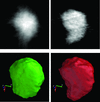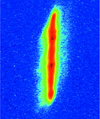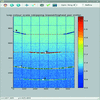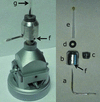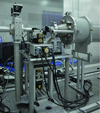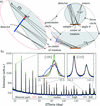issue contents
April 2015 issue

Cover illustration: (Foreground) A set of reciprocal space maps measured for nanowires consisting of a GaN core and an InGaN shell. (Background) A scanning electron microscopy image of the nanowires. Courtesy of Stankevic et al. [J. Appl. Cryst. (2015), 48, 344-349].
research papers
Small-angle X-ray scattering monitoring of tensile tests of polyurethanes from uniform components shows semi-rigid quasiperiodic sequences of hard domains which are related to the synthesis by polyaddition.
Download citation


Download citation


Structural investigations under temperature variation were carried out on Na0.5K0.5NbO3, using diffraction techniques and the symmetry mode analysis approach. The material underwent a series of three phase transitions: R3c → Amm2 → P4mm → Pm3m. A step forward in the use of the symmetry-adapted modes as degrees of freedom in the refinement process is reported
CCDC reference: 1043888
An accurate projection model is introduced for X-ray diffraction contrast tomography (CT) on conventional laboratory source µCT systems.
Measurements are made of strain and composition in InGaN/GaN heterogeneous nanowires and nanopyramids using reciprocal space mapping.
A sufficiently strong magnetic field can enhance the deep penetration capability of neutron diffraction by reducing the peak broadening.
Open  access
access
 access
accessThrough micro Laue tomography analysis, the depth-resolved cartographies (i) of NiO grains in a solid oxide fuel cell sample and (ii) of the full tensor of the deviatoric strain into a slice of a Ge sample are obtained.
A laboratory-based transmission X-ray diffraction technique was developed to measure elastic lattice strains parallel to the loading direction during in situ tensile deformation.
A wet-chemical spray-drying method was developed to synthesize homogeneous MgO:SLT powder to eliminate its antisite defects for high-quality MgO:SLT crystal growth.
Dynamic strain propagation in granular ceramics presents a cause of failure in industrial materials that undergo rapid thermal cycling. A mechanism based on degradation of grain contacts is proposed to explain the oscillatory nature of microstrain.
Open  access
access
 access
accessNonstoichiometric SrTiO3 thin films were fabricated by different thin-film deposition methods. The impact on the oxide/silcon interface stability as well as the crystallization onset temperature is investigated.
In this work the authors demonstrate the great potential of energy-resolved neutron imaging for studies of two important phenomena taking place in solid oxide fuel cell anode supports: accelerated creep and reduction of nucleation due to applied stress.
The dislocation densities and major slip-system populations in the different texture components of a rolled Zircaloy-2 plate are determined by neutron diffraction line profile analysis. Fourteen diffraction patterns were recorded in seven different orientations of the specimen, and diffraction patterns were composed by selecting texture-specific diffraction profiles.
A unified theory is developed to describe radial line broadening and rocking-curve broadening of diffraction peaks of dislocated crystals. It is shown that polar decomposition of the nonlocal strain tensor is more appropriate to describe the intensity distribution around fundamental Bragg reflections than separation into symmetrical and antisymmetric tensor components.
Open  access
access
 access
accessAn integrated environment for biological small-angle X-ray scattering (BioSAXS) at the high-brilliance P12 synchrotron beamline of the EMBL (DESY, Hamburg) allows for a broad range of solution scattering experiments. Automated hardware and software systems have been designed to ensure that data collection and processing are efficient, streamlined and user friendly.
Self-organized TiO2 nanotubular arrays with/without an Si coating are model anode materials in Li-ion batteries. Morphological parameters of such nanotubular arrays like nanotube radius, intertubular distance and porosity are determined with high statistical relevance using time-of-flight grazing-incidence small-angle neutron scattering (TOF-GISANS) and small-angle X-ray scattering (GISAXS).
The growth of β′′ precipitates during ageing of an Al–Mg–Si alloy is characterized in situ by small-angle neutron scattering on a single crystal. The length, diameter and number density of precipitates are measured.
Open  access
access
 access
accessQuantitative X-ray phase contrast imaging uniquely offers quantitative imaging information in terms of electron density maps allowing for mass and mass density determinations of soft biological samples (`weighing with light'). Here, it was carried out using coherent X-ray waveguide illumination, yielding values of the mass and mass density of freeze-dried bacterial endospores (Bacillus spp.).
The equations for simulating diffraction profiles and their implementation in computer code are presented for the cases of meridionally and sagittally bent crystals using the multilamellar and Penning–Polder theories and including crystal anisotropy.
Multireflection grazing-incidence X-ray diffraction (MGIXD) was used to determine the stress- and strain-free lattice parameter in the surface layer of mechanically treated tungsten and austenitic steel. A new interpretation of the MGIXD results was proposed and applied for the first time to measure the probability of stacking faults as a function of penetration depth.
Open  access
access
 access
accessThis article details the geometry, peak-picking, calibration and integration procedures on multi- and many-core devices implemented in the Python library for high-performance azimuthal integration.
It is shown that the melting and freezing temperatures of dilute sets of nanoparticles embedded in homogeneous matrices can be determined experimentally using only the small-angle X-ray scattering (SAXS) technique. From the analysis of the temperature dependence of SAXS intensity, the melting and freezing temperatures of a dilute set of Pb nanoparticles with an average radius 〈R〉 = 16.1 nm, embedded in a lead–borate glass, were determined to be 580 and 433 K, respectively.
Open  access
access
 access
accessThe basis-forbidden Si 200 and Si 222 reflections are investigated in detail as a function of the in-plane sample orientation Φ and the divergence perpendicular to the diffraction plane of the used diffractometer. The results have important consequences for the detection of layer peaks near these reflections.
Bulk single crystals of bismuth selenide with good crystalline perfection were grown successfully by introducing a necking process in the vertical Bridgman technique (VBT) through a specially designed VBT ampoule. The structure, crystalline perfection and layered nature were assessed, thermoelectric parameters were measured, and a significantly enhanced figure of merit compared to that reported in the literature was found. Nanoindentation analysis was carried out for the first time.
A procedure that allows one to correct for matrix effects in white-beam X-ray fluorescence holography is proposed.
Download citation


Download citation


The crystal structure of N,N′-methylenebisacrylamide was solved by combining molecular geometry optimization and crystal structure prediction analysis with standard diffraction techniques. The best structure was selected among thousands of predicted arrangements, comparing all calculated patterns with laboratory powder X-ray diffraction data, and was then refined with the Rietveld method. This approach allowed the twinning problems affecting the single-crystal data to be overcome, which eventually confirmed the predicted model.
A comprehensive description and ray-tracing simulations of symmetric nested Kirkpatrick–Baez mirrors are given. The correct alignment procedure, shape and multilayer coatings of the mirrors are simulated.
Scattering functions of polyhedra are presented, including regular, semi-regular, truncated, concave and stellated.
Download citation


Download citation


A new environmental control cell has been developed for use with current single-crystal diffractometer equipment, which provides the opportunity for in situ experiments on single crystals under non-ambient atmospheres and pressures. The design and fabrication of the cell as well as the results of a case study using this device are presented.
CCDC reference: 1051798
short communications
Open  access
access
 access
accessFor large-grained samples it is advantageous to perform pairs of neutron diffraction measurements at the same spatial location but rotated 180° around the geometric centre of the gauge volume as a means of minimizing the scatter coming from the random positioning of grains within the gauge volume.
A simple algorithm for computing the two-dimensional primitive basis vectors in an arbitrary crystallographic plane of an underlying three-dimensional lattice is proposed.
computer programs
The program EFRESOL calculates the effective resolution of a diffraction data set of an arbitrary completeness.
QUALX2.0 is the new version of QUALX. The main novelty of QUALX2.0 is the possibility of querying also a freely available database, POW_COD, built up by starting from the structural information contained in the Crystallography Open Database.
Open  access
access
 access
accessA software to reconstruct and visualize diffuse scattering in three-dimensional reciprocal space using data from X-ray area detectors is presented.
laboratory notes
High reciprocal spatial resolution grazing-incidence ultra-small-angle X-ray scattering measurements have been realized in a laboratory small-angle X-ray scattering setup via lengthening the distance between the collimation slit systems and the sample-to-detector distance.
Open  access
access
 access
accessThe influence of a straight linear detector on the powder diffraction signal in the Bragg–Brentano focusing geometry is presented. Recipes for how to limit resolution-degrading effects are developed.
book reviews
Free 



 journal menu
journal menu













